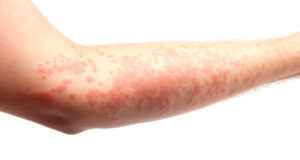 Taking care of a nasty case of allergies can be difficult and frustrating without the right home remedies on hand to alleviate symptoms. Hives are one of the most common reactions to topical allergies, meaning pollen, dust, or anything that touches the skin. This symptom is also a common reaction to certain food allergies, including strawberries and shellfish. Additionally, hives can be one of the most troublesome reactions, involving itchy, inflamed skin that is persistent and sometimes even painful. Of course, the best way to take care of hives on your own is to avoid getting them in the first place, which means bathing or showering after exposure to skin allergens and staying away from foods that cause a reaction. However, once you have hives, you still have a number of options to soothe your symptoms at home.
Taking care of a nasty case of allergies can be difficult and frustrating without the right home remedies on hand to alleviate symptoms. Hives are one of the most common reactions to topical allergies, meaning pollen, dust, or anything that touches the skin. This symptom is also a common reaction to certain food allergies, including strawberries and shellfish. Additionally, hives can be one of the most troublesome reactions, involving itchy, inflamed skin that is persistent and sometimes even painful. Of course, the best way to take care of hives on your own is to avoid getting them in the first place, which means bathing or showering after exposure to skin allergens and staying away from foods that cause a reaction. However, once you have hives, you still have a number of options to soothe your symptoms at home.
Before You Raid the Pantry, Try Temperature Therapy
The worst discomfort from hives often comes from the inflamed, itchy, painful skin surrounding the actual raised hives. Although inflammation won’t go away easily before you remove the allergen and apply an anti-inflammatory remedy, you can minimize the discomfort by manipulating the temperature of your skin. Try making a rice heating pad to keep on hand, which you can use to provide either warm or cool relief. Fill a clean sock with dry rice grains and stitch it or tie it closed. For heat, stick it in the microwave for thirty seconds and then apply it to the affected area. For cooling, freeze the pad and then apply. Some discomfort responds better to heat, while other discomfort responds best to cold, so you might need to experiment.
Finding Remedies in Your Own Pantry
You may be able to soothe your hives without even needing a trip to the store, as many of the most effective topical remedies come from ingredients that you already have on-hand. You can craft a soothing bath powder mixture and keep it in an airtight jar in anticipation of any sudden allergy attacks that may leave you affected by hives. Both baking soda and plain oatmeal can help your skin heal and reduce your urge to scratch. To make your own soothing bath for hives, combine one part baking soda with two parts oatmeal. You should ensure that the oatmeal is ground to a powder in a food processor or a blender before using it, as full-sized oatmeal grains will leave your bathtub difficult to drain and may clog your pipes. Remove half a cup to one cup, depending on the size of your bath, and stir it into warm water for your bath. Note that this remedy is unscented, so if you prefer to have a more pleasant bath, you can add essential oils or finely ground teas to the mix. Bergamot is a common anti-inflammatory and is found in Earl Grey tea, making it a good choice for scenting your bath. Other choices include thyme, fennel, cloves,, rose and eucalyptus. You can use essential oils, pre-dried teas, or dried leaves or petals to complete your oatmeal bath.
Another excellent option is adding a few cups of apple cider vinegar to your bath or using compresses soaked in apple cider vinegar on the affected areas. Although you might experience a bit of stinging at first, the apple cider vinegar should begin to relieve the inflammation quickly.
While baths are a great topical remedy, some people respond better to internal remedies that they can ingest with food. Because hives are an inflammatory response, you’ll find that any home remedy that reduces inflammation of the body overall is a good choice for reducing the severity of hives. Generally, these are internal remedies that you can take alone, as a tea or mixed into food. Note that if you choose to take an herbal or natural supplement, even a common one such as ginger, any prescription or over-the-counter drugs that you take might interact. To be safe, check with your doctor or pharmacist every time you add a new treatment to your regimen.
175 Teas, Tonics, Oils, Salves, Tinctures, and Other Natural Remedies for the Entire Family…
Spice Up Your Food with Turmeric
Turmeric, a spice that is known for its intense flavor and deep yellow color, is known for its anti-inflammatory properties. However, in addition, turmeric acts as a mild blood thinner. As such, you should avoid using it alongside anti-inflammatory painkillers such as naproxen or aspirin or if you already take prescription blood thinners. For inflammation, take up to three grams daily in any form. This can be as simple as adding a few dashes to your favorite spicy dish. Although you can take it as a tea if you want, it is more palatable with a food that you already eat moderately spiced. Turmeric is difficult to brew into a tea and works better with food.
Brew a Cup of Ginger Tea
Ginger is one of the most popular anti-inflammatory herbs available, and you can use it in many forms. It works by targeting the genes and enzymes that trigger inflammation as a response to stimulation or irritation, limiting the response and rendering the symptoms easier to handle. If you can tolerate the strong flavor, you can take ginger by itself and fresh. Otherwise, you can add ginger to all manner of baked goods and savory foods. It pairs well with sweet flavors, such as pear or mandarin. However, if you are looking for a quick fix and prefer not to cook, you can brew ginger tea by adding a tablespoon of grated fresh ginger to boiling water and brewing for five minutes. It is important to grate the ginger instead of adding a whole chunk, as the grating will expose more surface area and allow the tea to steep more effectively. Finally, if you want ginger tea without using fresh ginger, there is a huge selection of ginger teas on the market that require less preparation.
Don’t Waste Time on Remedies That Won’t Work
If you have allergies badly enough to have hives as a response, chances are that you are sensitive to one of the anti-itch topical creams that are available over-the-counter. This is especially true if your hives are the result of a topical allergen rather than a food allergy or an inhaled allergen. Calamine lotion is not often an allergy trigger, but it also fails to work for allergy-induced hives because it works by drying out the afflicted area. This makes it effective for weeping itches, but not regular hives.
You may not find the right remedy for your hives on the first try. Everybody is different, and each person reacts differently to the same home remedies. If you find that oatmeal baths do not work for you, try apple cider vinegar or turmeric and see what happens. Often, it takes several tries to find a remedy that works really well, but once you find the right one, you’ll experience relief, save money by avoiding expensive medications, and get a better understanding about how to care for yourself naturally.
Remember to always check with your physician or health-care professional before trying any new treatment. In addition, if you experience severe hives, including those on the neck or face, or if you begin to have trouble breathing, seek medical attention immediately.
©2013 Off the Grid News











